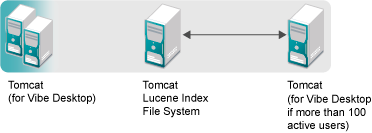A.4 Medium Installation

This deployment is suitable for a medium-to-large business. The database server is separate, to increase the amount of parallel processing in the system. The database can be a single server or a cluster of database servers. More memory is also allocated to the Vibe server. If Vibe Desktop is being used with more than 100 active users, it must be running on multiple separate Vibe (Tomcat) servers.
|
Vibe Components |
CPU |
Memory |
Java Heap |
|---|---|---|---|
|
Multiple Vibe servers:
|
3Ghz x64 quad-core |
4–8 GB |
6 GB |
For information on how to create a separate Vibe database, follow the instructions specific to your database type, as described in Section 19.0, Creating the Vibe Database on a Separate Server.
For more information on how to configure Vibe Desktop to run on your Vibe server, as well as how to distribute Vibe Desktop synchronization traffic to a dedicated Vibe server, see Providing File Access and Editing for Vibe Users
in VibeSite Setup
in the OpenText Vibe 4.0.8 Administration Guide.
You can perform a Basic installation to set up a multiple-server configuration (as described in Section 8.0, Planning a Basic (Single-server) Vibe Installation and Section 11.0, Installing and Setting Up a Basic Vibe Site); however, the separate database must be created manually and in advance of performing the installation, as described in Section 19.0, Creating the Vibe Database on a Separate Server.